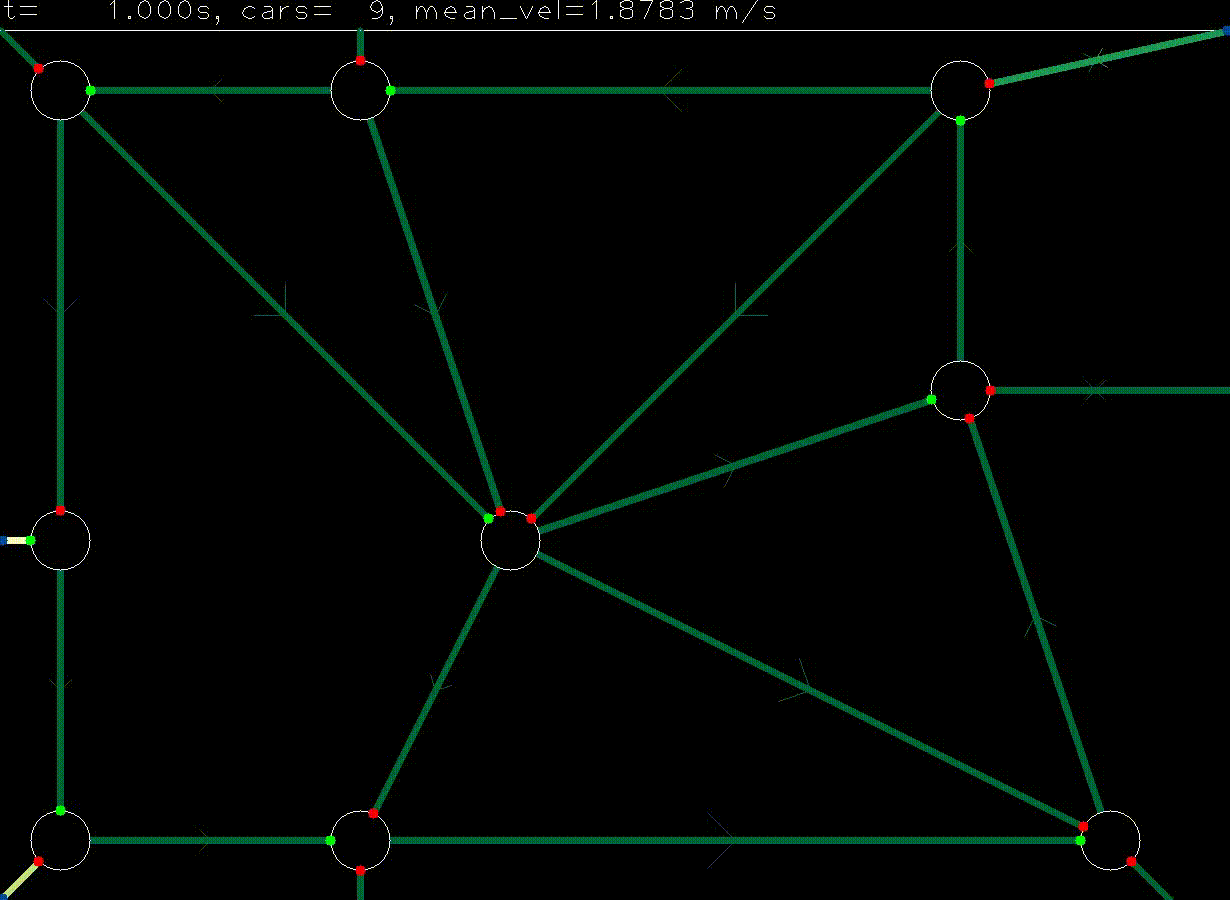OpenAI Gym Environment for traffic lights simulation:
- Street network as directed graph
- The world consists of multiple intersections.
- Intersections are connected with streets.
- Intersections have traffic lights for each incoming street.
- Traffic lights can either be red or green.
- For each intersection there cannot be more than one green light.
- Vehicles can spawn at some intersections with a predefined route.
- Vehicles drive on streets and stop at red traffic lights.
- Vehicles do not crash into each other.
An Agent has to control the traffic lights.
Example using the graph_3x3circle-world and the ppo-meta-acceleration-agent:

This project was solved using Python 3.8.6
Requires:
- OpenAI gym (
pip intall gym) - PyTorch (Installation Guide)
- OpenCV (
pip install opencv-python) (for visualization) - tqdm (
pip install tqdm) (for progressbar in evaluation) - stable-baselines3 (for training agents) (
pip install stable-baselines3)
There are different environment and reward types which can be combined in any way:
There are two different environments from which one can choose:
In this environment all traffic lights have to be controlled simultaneously.
The observationspace varies depending on the design of the used street network.
The actionspace can be described as Multi-Discrete, as every intersection has its own discrete action.
From this following features derive:
| Features | Features | ||
|---|---|---|---|
| Fully observable | YES | Partially observable | NO |
| Static | NO | Dynamic | YES |
| Discrete | NO | Continuous | YES |
| Deterministic | NO | Stochastic | YES |
| Single agent | YES | Multi-agent | NO |
| Competitive | NO | Collaborative | YES |
| Episodic | YES | Sequential | NO |
In this environment only on intersection can be controlled at one timestep and observation is only given for this intersection. It is assumed that there are k incoming streets at every intersection.
This results in a observationspace of k values, independent of the intersection or design of the street network.
The actionspace is a single discrete action ranging from 0 to k for each timestep.
Therefore a slightly different feature-matrix derives:
| Features | Features | ||
|---|---|---|---|
| Fully observable | NO | Partially observable | YES |
| Static | NO | Dynamic | YES |
| Discrete | NO | Continuous | YES |
| Deterministic | NO | Stochastic | YES |
| Single agent | YES | Multi-agent | NO |
| Competitive | NO | Collaborative | YES |
| Episodic | YES | Sequential | NO |
With this reward type the mean velocity for all vehicles is calculated and normalized around approximately 0: r=(r'-5)/5
With this reward type the acceleration is calculated by dividing the difference of two mean velocities by dt.
| parameter | description | possible settings/default |
|---|---|---|
| horizon | number of steps in until done | 1000 |
| calculation_frequency | time steps in which the simulation is calculated | 0.01 |
| action_frequency | time which has to pass until env asks for new action | 1 |
| reward_type | Method that gives the reward | mean_velocity, acceleration |
| parameter | description | possible settings/default |
|---|---|---|
| world | The actual design of the street network | |
| horizon | number of steps in until done | 1000 |
| calculation_frequency | time steps in which the simulation is calculated | 0.01 |
| action_frequency | time which has to pass until env asks for new action | 1 |
| reward_type | Method that gives the reward | mean_velocity, acceleration |
| shuffle_streets | order of observation is randomized if set to true. Can be helpful for training | True, False |
| k | Number of streets that should be considered | 8 |
The training was done with following setup:
| OS | Windows 10, Version 1909 |
| CPU | Intel(R) Core(TM) i5-10500 CPU @ 3.10GHz, 3096 MHz |
| RAM | 32GB DDR4 (2666MHz) |
| GPU | NVIDIA Quadro P2200 |
An example for training an agent with this environment is given in src/examples/train.py
Execute with:
cd src
python examples/train.pyEach model was evaluated at least 5 times. To verify these results one can use the savepoints provided in this repository and the evaluate.py in src/examples.
| Algorithm | Mean Velocity | Sum reward/1000 steps (acceleration) | Steps/Hours trained |
|---|---|---|---|
| random | 4.200 | 2.626 | - |
| ppo-acceleration | 6.120 | 4.672 | 1.5M steps (~10 hours) |
| Algorithm | Mean Velocity | Sum reward/1000 steps (acceleration) | Steps/Hours trained |
|---|---|---|---|
| random | 5.525 | 5.645 | - |
| argmax | 8.115 | 8.023 | - |
| PPO-velocity | 6.383 | 5.815 | 1.5M steps (~9h) |
| PPO-velocity-shuffled | 7.736 | 8.548 | 1.25M steps (~ 7.5h) |
| PPO-acceleration-shuffled-1 | 7.991 | 7.522 | 1.25M steps (~ 7.5h) |
| PPO-acceleration-shuffled-2 | 7.987 | 5.775 | 1.25M steps (~ 7.5h) |